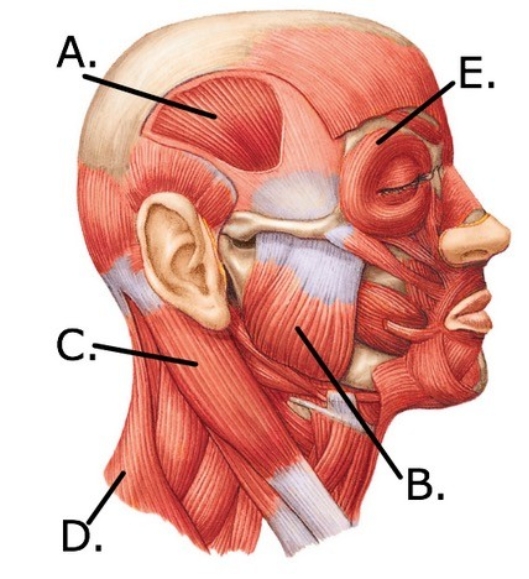A) Coracobrachialis
B) Deltoid
C) Pectoralis major
D) Biceps brachii
E) Serratus anterior
G) A) and B)
Correct Answer

verified
Correct Answer
verified
Multiple Choice
The abdominal muscle that has its origin at the pubic crest and symphysis pubis is the ________.
A) rectus abdominis
B) transversus abdominis
C) external abdominal oblique
D) internal abdominal oblique
E) linea alba
G) A) and E)
Correct Answer

verified
Correct Answer
verified
Multiple Choice
 -The figure illustrates a lateral view muscles of the head and neck. Which muscle is indicated by "D"?
-The figure illustrates a lateral view muscles of the head and neck. Which muscle is indicated by "D"?
A) Orbicularis oculi
B) Temporalis
C) Trapezius
D) Sternocleidomastoid
E) Masseter
G) A) and E)
Correct Answer

verified
Correct Answer
verified
Multiple Choice
Which of the following is a group of four muscles in the anterior thigh?
A) Quadriceps femoris
B) Sartorius
C) Biceps femoris
D) Tensor fasciae latae
E) Gracilis
G) B) and C)
Correct Answer

verified
Correct Answer
verified
Multiple Choice
Which of the following muscles is found in the lateral compartment of the leg?
A) Plantaris
B) Tibialis anterior
C) Fibularis longus
D) Extensor digitorum longus
E) Soleus
G) None of the above
Correct Answer

verified
Correct Answer
verified
Multiple Choice
The muscles of the anterior group of forearm muscles are primarily ________.
A) flexors
B) extensors
C) abductors
D) adductors
E) supinators
G) B) and E)
Correct Answer

verified
Correct Answer
verified
Multiple Choice
The rotator cuff muscles
A) fix the scapula in place.
B) attach the arm to the thorax.
C) attach the clavicle to the humerus.
D) hold the head of the humerus in the glenoid fossa of the scapula.
E) attach at the distal end of the humerus.
G) C) and E)
Correct Answer

verified
Correct Answer
verified
Multiple Choice
Raising the eyebrows is the action of the ________ muscle.
A) auricular
B) procerus
C) occipitofrontalis
D) levator palpebrae superioris
E) temporalis
G) B) and E)
Correct Answer

verified
Correct Answer
verified
Multiple Choice
 -The figure illustrates a lateral view muscles of the head and neck. Which muscle is indicated by "E"?
-The figure illustrates a lateral view muscles of the head and neck. Which muscle is indicated by "E"?
A) Orbicularis oculi
B) Temporalis
C) Trapezius
D) Sternocleidomastoid
E) Masseter
G) A) and E)
Correct Answer

verified
Correct Answer
verified
Multiple Choice
The extensor pollicis brevis moves the ________.
A) forearm
B) fingers
C) thumb
D) retinaculum
E) palm
G) A) and B)
Correct Answer

verified
Correct Answer
verified
Multiple Choice
The prime mover is
A) a muscle working in opposition to another muscle.
B) the end of the muscle where the action occurs.
C) the muscle that does most of the movement.
D) the stationary end of the muscle.
E) a group of muscles that work together to cause movement.
G) A) and E)
Correct Answer

verified
Correct Answer
verified
Multiple Choice
The sternocleidomastoid muscle extends from the mastoid process of the temporal bone to the sternum and medial clavicle. When both sternocleidomastoid muscles contract, the head is flexed. The end of the muscle that connects to the sternum is the ________.
A) origin
B) belly
C) body
D) insertion
E) fixator
G) A) and E)
Correct Answer

verified
Correct Answer
verified
Multiple Choice
Which abdominal wall muscle is the most superficial of the oblique muscles?
A) Rectus abdominis
B) External abdominal oblique
C) Internal abdominal oblique
D) Transversus abdominis
E) Quadratus lumborum
G) None of the above
Correct Answer

verified
Correct Answer
verified
Multiple Choice
Which of the following is found in the posterior group of forearm muscles?
A) Palmaris longus
B) Flexor carpi radialis
C) Abductor pollicis longus
D) Flexor digitorum profundus
E) Flexor digitorum superficialis
G) B) and D)
Correct Answer

verified
Correct Answer
verified
Multiple Choice
Which muscle everts and plantar flexes the foot?
A) Tibialis anterior
B) Soleus
C) Extensor digitorum longus
D) Extensor hallicus longus
E) Fibularis brevis
G) A) and C)
Correct Answer

verified
Correct Answer
verified
Multiple Choice
After taking their wedding vows, a bride and groom often ceremonially use which of the following muscles before walking away from the altar?
A) Depressor anguli oris
B) Orbicularis oris
C) Levator labii superioris
D) Platysma
E) Quadriceps femoris
G) C) and D)
Correct Answer

verified
Correct Answer
verified
Multiple Choice
Which of the following muscles moves the scapula?
A) Trapezius
B) Biceps brachii
C) Latissimus dorsi
D) Pectoralis major
E) Triceps brachii
G) A) and E)
Correct Answer

verified
Correct Answer
verified
Multiple Choice
The levator palpebrae superioris muscle
A) puckers the mouth for kissing.
B) contributes to pouting.
C) contributes to laughing and smiling.
D) causes crow's feet wrinkles.
E) raises the eyelid.
G) A) and C)
Correct Answer

verified
Correct Answer
verified
Multiple Choice
Which muscle acting on the arm assists in deep inspiration?
A) Pectoralis major
B) Trapezius
C) Teres minor
D) Diaphragm
E) Deltoid
G) None of the above
Correct Answer

verified
Correct Answer
verified
Multiple Choice
A male sustains a crushing injury to his foot. After weeks of care, he begins to notice that he cannot bend the little toe on his right foot. Which of the following would be a logical diagnosis?
A) Atrophy of the flexor hallucis brevis
B) Atrophy of the fibularis brevis
C) Atrophy of the soleus
D) Atrophy of the flexor digiti minimi brevis
E) Atrophy of the adductor hallucis
G) B) and C)
Correct Answer

verified
Correct Answer
verified
Showing 41 - 60 of 168
Related Exams